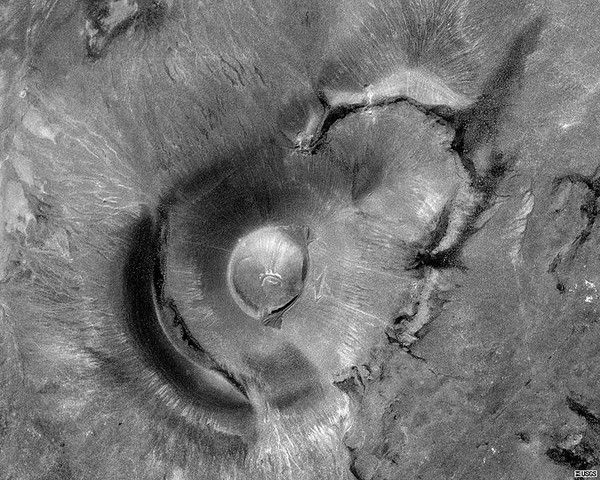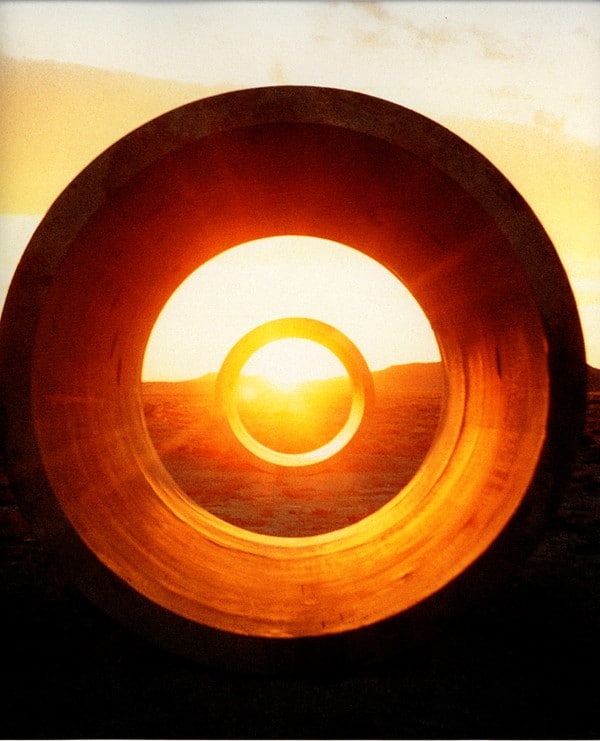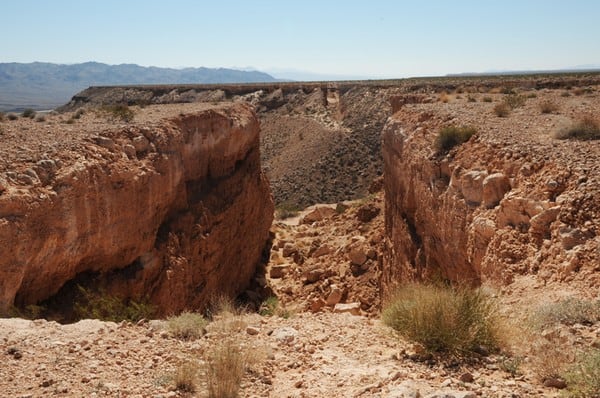日前写《艺术生态对话专着: Land, Art: A Cultural Ecology Handbook 》,要找 Land Art 的相关资料,才发现无论定位、以至要追溯 Land Art 都非常困难,在维基上中、英两个版本更完全不同:
Land art is to be understood as an artistic protest against the perceived artificiality, plastic aesthetics and ruthless commercialization of art at the end of the 1960s in America.
大地艺术的创作旨在对地景的讨论,其作品经常出现在对公众开放,远离都市文明的地区。
既然不是重点,在《Land, Art》一文我就乾脆跳过了这部分。(亲爱的读者我对不起你们啊。)

Sun Tunnels, Nancy Holt
为了赎罪和满足好奇心,我就跑到图书馆借来一些关于 Land Art 的书籍,好好写一写这个 Land Art 。一翻开 Gilles A. Tiberghien Land Art Introduction 的第一页,就更触到我痛处:
Common sense would seem to advise against writing a book on Land Art, not because the subject has been abundantly discussed, but rather because the term itself is extremely vague
Land Art 一词定义如此模煳,令了没有太多艺术家愿意以 Land Art 来形容作品,但他们反而选择涵盖范围更广、定义更模煳的字眼如 Environmental Art/ Ecological Art 。
Land Art 有时候也叫 Earthworks 或 Earth Art ,1968年在纽约 Dwan Gallery 的展览就命名为 Earthwork 。然而两者并非完全一样: Earthworks 这个字涵盖面比 Land Art 为小,对于 Jan Dibbets 、 Richard Long 和 James Turrell 的作品都不合适。艺术家 Michael Heizer 更宁愿用 Sculptures ,也不愿意用 Earthwork 这个字眼。
- Construction of a Wood, Jan Dibbets
- A Line and Tracks in Bolivia, Richard Long
- Complex I, Michael Heizer
Land Art 一词相比之下更为广泛,能够涵盖到非常多元化的作品。虽然 Earth 在意指整个星球的层面上,更贴近艺术家们使用的元素(风、水、火、土等),但某程度上, Land 比 Earth 更容易理解。
《Land, Art》一文介绍过 Land Art 的原料:
作品从大自然取材,如泥土、石头、树枝、树叶、水等等有生命的元素,甚至天气──如已故艺术家 Walter De Maria 的作品 Lightning Field ,就以雷电作为作品要素。
不过作品原料也不必悉数为大自然,如上面提及的 Lightning Field ,它的不鏽钢柱就非大自然元素。话虽如此,其实本来所有事物,都是源自大自然;又,其实所有大自然的事物,在转化成艺术品的过程中,哪怕只是改动了位置,都已经是人工的了。
作品也是场域特定 (site-specific) 的,换言之,四周的风景也是作品元素之一,如 Nick Kaye 在着作 Site Specific Art: Performance, Place, and Documentation 中所言, “to move the site-specific work is to re-place it, to make it something else” 。
美国艺评人 Rosalind Krauss 文章Sculpture in the Expanded Field就提出当代艺术,尤其是凋塑,必须符合两个条件:
In this sense sculpture had entered the full condition of its inverse logic and had become pure negativity: the combination of exclusions. Sculpture, it could be said, had ceased being a positivity, and was now the category that resulted from the addition of the not-landscape to the not-architecture.
这个条件就造就了一种完全独立存在、自我指涉 (self-referential) 的艺术形式,不必凭藉四周环境、文本 (context) 和观者的环境来诠释作品的题旨。 Krauss 设想,除了文本,现代艺术也不依赖观者对它的观感、理解、分析,能够建立并散发自身的含义。本质上,现代艺术的作品,并不需要观者来判定它为艺术,由基础上,它就是艺术。
在场域特定作品中,脉络 (context) 的存在是必要的,和 Krauss 的理论某程度上可谓背道而驰。
那麽,做场域特定的意义又为何?艺术史学家 Miwon Kwon 就提出以下四点:1)它希望能跨越传统媒介如画作、凋塑的限制;2)挑战在 context 遭受突发情况下,艺术作品意涵或会面对的变更;3)以重组主体来得出 phenomenology 的效果(就是专注于观者的知觉和直接体验);4)抵御资本主义市场和其附带的商品化。
换言之,它们放置于淼无人烟的地方,都是有其用意的。正如 James Turrell 的作品 Roden Crater 本身,就是一座山。以下是博客查映岚在《感官侵略战》中的介绍:
艺术家固然经常以光作为主要创作媒介,但其实把他 (James Turrell) 归类为 light artist 并不准确,例如他的代表作《罗丹火山口》就是极有名的地景艺术,甚至有人称之为歴史上野心最大的艺术作品。70年代中, Turrell 以积蓄买下一架小型飞机,在几个月之间在美国西部到处飞,想要找寻一座被平原环绕的小山做作品,晚间就随意降落,餐风露宿。后来他找到了那座名为罗丹的死火山,本来找到艺术基金买下了土地,但基金陷入财困,经过几番折腾才又找到愿意贷款给他的银行。只是妻子由始至终坚决反对,认为他为了一座死火山抵押掉孩子的未来,结果两人因为各种分歧而离异——可是谁又能怪她呢,为了搞艺术而买下一座死火山连周边的几个牧场,怎麽看都很疯狂嘛。 Turrell 穷数十年的时间与精力,在山中挖掘地道和房间,改变火山口的形状,从里面看到的是真实的天空,却也是艺术家精心建构的幻象。
James Turrell 的作品同样也是一个过程──途中漆黑一片,观者找到了作品的空间,眼睛逐渐适应黯澹的光线,四周事物的轮廓慢慢变得清晰,作品黑白的影像越来越可视,然后终于看得到天空和流光的画面──然而这是一个极其脆弱的平衡,一个光与影的平衡,一如其他 Land Art 作品。
这件作品早在未完成的时候,已经吸引了很多人前来「朝圣」。即使要「又越过高山又越过谷」,作品更有警卫24小时看管,还是有很多人擅自进入,偷偷率先感受,还拍下照片放到 Flickr 上开心 share !
想要偷偷进去的话,你只能从火山口爬进去。你攀过火山口,将看到两片澹光倒在脚下,然后你爬下,接近,凝视,只见一个金黄色楼梯通往房间。作品的房间十分宁静,一呼一吸都能听见,每一句低语都引来回音。
其中一个 Flickr 用家就警告,前往 Roden Crater 过程非常严峻: “Be aware that the desert is not a forgiving place, and that the crater is remote, many miles from the nearest paved road. You can die trying to get there.”
Robert Smithson 的 Spiral Jetty 则置于犹他州大盐湖东北部的海岸,以泥土、盐晶体、玄武岩和水,从湖边逆时针延伸出去,这条曲线足足460×4.6米,规模非常大,不同角度拍摄效果都不一样。
湖泊的水位变化也影响到作品。乾旱的时候,作品就会浮现,而其他时候作品则会被淹没。由于盐的结殻作用,原本黑色的玄武岩和泛红的水,现在变成了大部分白色的岩石和粉红色的湖水。
- Spiral Jetty
- Spiral Jetty
- Spiral Jetty
他的作品非常有名,网上很多部落格都有提及。其中一个博客如是说:
I continue to be caught up and compelled by the ongoing saga of the Spiral Jetty. It is a touchstone for so many compelling personal themes: the unique power that is an art pilgrimage site; the geographic connection I feel to the land in Utah…; the large scale power of Smithson’s construction to frame and define that exquisite desert expanse; the ongoing organic evolution of the structure as the years leave their marks, like the coat of crystallized salt, on the jetty stones.
其他博客都纷纷认同,他们以「让人平静 (Calming) 、冥想的 (Meditative) 、鼓舞人心的 (Inspiring) 、具对抗性的 (Hostile) 、孤独的 (Solitary) 、神话的 (Mythological) 、无限的 (Infinite) 」来形容这件作品。
除了文字,网上亦有很多人和作品合照,有些人双手举起,亦有人像在以瑜伽姿势冥想。
Spiral Jetty 的中心彷佛有着磁力般的魅力,即使作品被湖水淹没,还要忍受盐晶刺痛脚板,观者也愿意探身涉水,走到盐水中央,进入作品的空间之中,深入地感受它。
同样不得不提的,还有 Nancy Holt 的 Sun Tunnels 和 Michael Heizer 的 Double Negative 。
Sun Tunnels 也是于犹他州创作的,它位于鬼镇 Lucin 外的大盆地沙漠 (Great Basin Desert) 中,为 Holt 对阳光在城内和沙漠内强度差异的探索。她在 Touching the Sky: Artworks Using Natural Phenomena, Earth, Sky and Connections to Astronomy 提及选择大盆地沙漠的原因:
“It is a very desolate area, but it is totally accessible, and it can be easily visited, making Sun Tunnels more accessible really than art in museums . . . A work like Sun Tunnels is always accessible . . . Eventually, as many people will see Sun Tunnels as would see many works in a city-in a museum anyway.”
这件作品由四个放成 X 型的巨型溷凝土隧道(18尺长,直径9尺)组成,全长86尺,在远至一里多以外的地方都能看见。每条隧道面向不同方向,在不同时候如日出、日落、夏天、冬天等,对阳光都有不同反应。透过隧道,沙漠的风景变得完全不一样。当几个隧道能轻易改变景色,就提出了一个空间观感 (perception of space) 的问题。
和 Spiral Jetty 一样,很多来「朝圣」的人都认为 Sun Tunnels 是对精神上有重大意义的空间,更有人聚集在隧道中间进行某种仪式。
在 Sun Tunnels 一众粉丝中, Jim Vanderwest 算是较为有名的一个,他由2000年开始,每年夏至 (summer solstice) 都会到 Sun Tunnels 处观赏日出和日落。他认为这件作品非常独特: “You’ve got this rare flat earth with no human involvement where you see the effects of geology over time. And, what’s basically coming together here is the celestial forces. A thing that civilizations ago figured out the movement of the sun and here it is evidenced right before you.”
Double Negative 的名字指的,则是作品中由自然和人工造成的负空间 (negative space) 。所以这件作品并不是看那裡有什麽,而是没有什麽。作品为一条9米阔,15米深,457米长的大沟,由 Michael Heizer 「愚公移山」了244,000吨岩石创作而成。
对于作品场域特定的元素, Michael Heizer 却这麽说:
”The work does not belong to any specific site. The site does not come before the work, nor is it first in relation to it; rather, it is the work that constitutes the site and gives the site its identity. To think opposite would be as simplistic as to think that the constraints of the material determine the forms of the sculpted object. Double Negative could have been located elsewhere.“
不过 Land Art 作者 Tiberghien 则说,某个层面来说,作品的场域的确会由艺术和场地的相互关係中,赋予作品一些含义或意义。
“In this sense, Heizer has reason to keep his work independent from the general site. But his creation carries along ipso facto that of the site as well, thus engendering a relationship of reciprocal belonging.”
而 Lightning Field 在《知名艺术家 Walter De Maria 逝世》一文已有提及,我就搬字过纸,不多着墨了:
一在1977年于美国新墨西哥州创作的大地艺术 (land-art) 作品。The Lightning Field 由400支不鏽钢柱排列而成,整件作品长1公里,阔一英里。作品一年只开放六个月,观众虽在作品远处的一所小屋中住宿,当雷电击中作品时,不鏽钢柱便会产生一张可见的电网。
不幸地,艺术学术期刊 October 派别(上文提及的 Rosalind Krauss 为 October 创办人)的人并不太喜欢这类作品, Lightning Field 在 October 第16期更被 Earthworks and Beyond: Contemporary Art in the Landscape 作者 John Beardsley 就作品的监管狠批艺术家本人及 Dia Art Foundation ,称这种控制「杜绝了」 (forecloses) 观者的「独立评估」 (independent appraisal) ,并使就「自身的优点」 (its own merits) 来讨论这件作品这件事变得不可能:
“Not only do the machinations of the artist and his sponsors in this case reveal contempt for the enterprise of criticism, but, more importantly, they call into question the very possibility of a criticism that seeks independence from the controlling factors of any artwork’s context.”
下一部,我们再来看看,为什麽这些作品都要放在荒山野岭?这种场域又为作品观感带来怎样的效果?另外,实际上 Land Art 在精神上有什麽象徵?
--
其实我在 Land Art 方面还是入门新手,有关资料和简介若然有误,还望各位高抬贵手,多多指正。
文章来源:艺术主场;作者:小魚仙 本文链接地址: 荒芜中的魅力:详谈大地艺术(一)





















